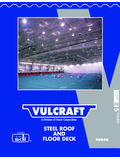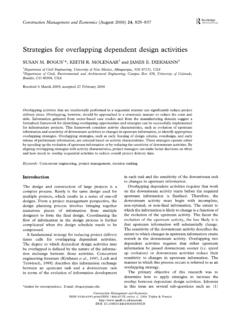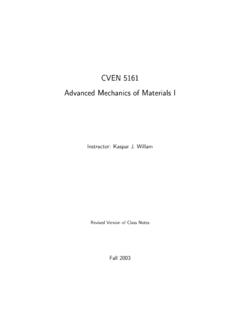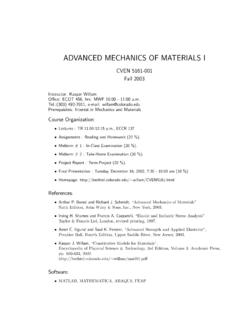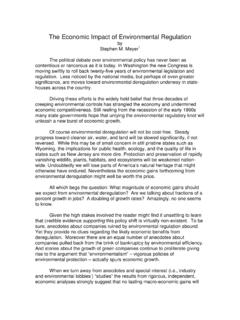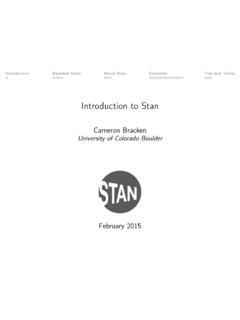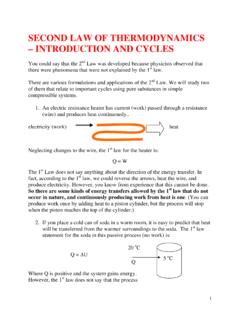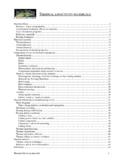Transcription of THERMAL RESPONSE OF REINFORCED CONCRETE …
1 1 THERMAL RESPONSE OF REINFORCED CONCRETE STRUCTURES in nuclear POWER PLANTS Kaspar Willam, Yunping Xi , Keun Lee and Byunhun Kim SESM No. 02-2009 Department of Civil, Environmental, and Architectural Engineering College of Engineering and Applied Science University of Colorado at Boulder 2 TABLE OF CONTENTS Part I 1 5 2 Responses of CONCRETE to High 6 Damage mechanisms of CONCRETE under high 6 Phase transformations in cement paste .. 6 Phase transformations in 8 THERMAL incompatibility between cement paste and 8 Strength of CONCRETE under high temperatures .. 8 Experimental results on strength of CONCRETE under high 10 ACI specifications on the strength of CONCRETE under high 13 The temperature to start the reduction of compressive 15 The effect of pre-loading on strength of CONCRETE under high temperatures.
2 19 Prediction of CONCRETE strength under high temperatures .. 21 Stiffness of CONCRETE under high 22 Experimental results on stiffness of CONCRETE under high temperatures .. 22 Prediction of stiffness of CONCRETE under high 24 Stress-strain relations of CONCRETE under high temperatures .. 25 Experimental results on stress-strain relations of CONCRETE under high temperatures .. 25 Prediction of stress-strain relations of CONCRETE under high temperatures .. 27 THERMAL expansion of CONCRETE under high temperatures .. 28 Creep and shrinkage of CONCRETE under high temperatures .. 30 Creep of CONCRETE under room temperature .. 30 Experimental results for creep of CONCRETE under high temperatures.
3 32 Aging of CONCRETE creep properties at different 34 Modeling creep of CONCRETE under high 36 Shrinkage of CONCRETE under high 37 The coupling effects among loading, drying, and 38 The interactive effects among U, P, and 38 Modeling the coupling effects .. 42 Porosity and weight loss of CONCRETE under high 44 THERMAL transport properties of CONCRETE under high temperatures .. 46 3 Responses of Reinforcing Steel to High Temperatures .. 49 Experiments on stress-strain curves of steel under high temperatures .. 49 Predicting responses of steel to high temperatures .. 49 Tensile Strength .. 50 Modulus of Elasticity .. 51 THERMAL expansion and free THERMAL 52 THERMAL transport properties of Steel under high 53 4 The Bond between CONCRETE and Steel.
4 56 Testing methods for bond strength .. 56 Experimental results on the bond 56 5 Conclusions of Part 60 36 References of Part 61 Part II 7 Observations of Fire Experiments .. 66 Beam tests ..66 Column 75 REINFORCED CONCRETE structure systems for floor and slab .. 87 8 Analysis of REINFORCED CONCRETE Structures under High 95 Fire analysis of RC 95 Fire analysis of RC Columns .. 112 Numerical studies of other RC members and 118 9 Performance Study of RC Flexural Members under High 127 Sectional 127 RESPONSE behavior of unrestrained vs. restrained RC beams .. 132 Experimental results .. 132 Residual moment capacity of the beams .. 134 Deflection of the beams.
5 140 Summary .. 147 10 National and International Design Standards .. 148 Standards for Fire 148 International Standard ISO 834 (1975) .. 148 ASTM E119 (2007) .. 149 Japanese Industrial Standard JIS A (1994).. 150 High Temperature Design Specifications for RCS .. 151 ACI (2007).. 151 ACI (2007) .. 153 11 References of Part II .. 160 Part III 12 CONCRETE spalling under high 163 13 Influential Factors on CONCRETE Spalling .. 164 Types of 164 Factors of influencing 166 Interaction of key factors on 171 14 Experimental Studies ..173 CONCRETE cylinder .. 173 Test set-up and procedure .. 173 REINFORCED CONCRETE column .. 176 15 Theoretical Background in Poromechanics.
6 180 Thermohygro processes .. 180 Four Field Formulations vs. Three Field Formulations .. 182 Mass balances .. 182 solid 182 Liquid water 183 4water vapor 184 Energy 185 Momentum 185 Mass balances .. 186 solid 186 Liquid water 187 water vapor 187 water species: liquid water +vapor water 187 Energy balance equation .. 189 Momentum 189 16 Spalling Risk Category ..195 Defining spalling risk categories [ Arup Group 2005] .. 195 Assessment of the THERMAL spalling risk [Gawin, Pesavento, Schrefler 2006] .. 197 Analytical assessment of spalling risk using CONCRETE model .. 201 17 Conclusions of Part III .. 205 18 References of Part III .. 206 5PA RT I : HIGH TEMPERATURE PROPERTIES OF CONCRETE AND STEEL 1 Introduction This is the report for a research project sponsored by Oak Ridge National Laboratory in 2008 2009.
7 The objectives of the project were to review and summarize THERMAL responses of REINFORCED CONCRETE structures used in nuclear power plants. There are totally three parts of the report. The first part focuses on responses of various materials under high temperatures including CONCRETE and steel, the second part on structural performances, and the third on spalling damage of CONCRETE under high temperatures. The first part of the report includes several aspects: damage mechanisms of the materials under high temperatures, available experimental results, current code specifications, and prediction models for THERMAL responses of the materials.
8 The material properties include strength, stiffness, stress-strain relations, transport properties ( THERMAL conductivity), short-term THERMAL expansion, long-term THERMAL creep, shrinkage, and the interactive effects among temperature variation, vapor diffusion, and mechanical loading in CONCRETE . The bond behavior between CONCRETE and steel under high temperatures is also included. This part is listed as the first part of the report, because THERMAL responses of REINFORCED CONCRETE structures used in nuclear power plants depend on THERMAL responses of materials such as CONCRETE and steel under high temperatures.
9 The second part of the report focuses on the structural responses of REINFORCED CONCRETE structures under high temperatures, such as beams, columns, and slabs. The second part of the review includes available experimental results, current code specifications, and prediction models for THERMAL responses of the REINFORCED CONCRETE structures. In addition, we developed a numerical model for characterizing high temperature responses of REINFORCED CONCRETE beams. The model prediction was compared with available test data in the literature and with predicted results by a commercial finite element code. The third part of the report is for spalling damage of CONCRETE under high temperatures, which is a special form of fire damage when the heating rate is very high.
10 The review includes experimental results, damage mechanisms, and theoretical and numerical analysis. A recently developed numerical model and experimental results obtained by the authors were described in detail together with a comprehensive literature review on spalling damage of CONCRETE . 6 2 Responses of CONCRETE to High Temperatures Damage mechanisms of CONCRETE under high temperatures There are four types of major damage mechanisms responsible for deterioration of properties of CONCRETE under high temperatures: (1) phase transformations taking place in cement paste; (2) phase transformations taking place in aggregate; (3) THERMAL incompatibility between the cement paste and aggregate; and (4) spalling of CONCRETE .
